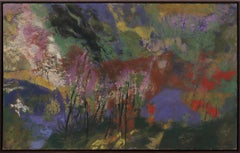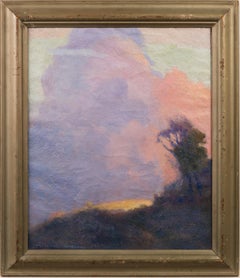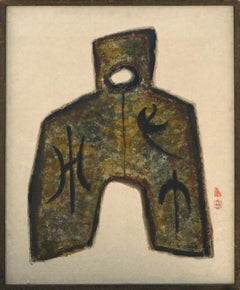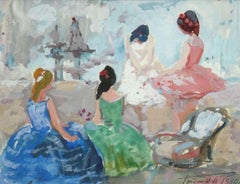Tempera Abstract Paintings
to
1
3
1
1
2
2
1
2
1
Overall Height
to
Overall Width
to
191
37
33
4
4
3
2
1
4
1
1
1
1
1,393
1,035
689
679
667
Style: Impressionist
Medium: Tempera
Springtime, 1960s Semi Abstract Modernist Mountain Landscape Tempera Painting
Located in Denver, CO
"Springtime" is an original tempera on board painting of a Colorado mountain landscape painting by Ethel Magafan circa 1960. Abstracted mountain landscape with trees, painted in colors of green, purple, golden yellow, red, orange, blue, black and white. Presented in a custom hardwood frame, outer dimensions measure 23 ¼ x 50 x 2 inches. Image size is 30 x 48 inches.
Provenance: Private collection, Maine
Acquired in the early 1960s, by descent through the family to the present owner
About the Artist:
Jenne and Ethel Magafan were identical twins, born in Chicago to a Greek immigrant father and a Polish mother. Due to health concerns about their father, the family moved to Colorado, living first in Colorado Springs and then in Denver. He was a proud supporter of their artistic ambitions but died suddenly 1932, a heavy blow to both of them. They attended East High School in Denver, where they found a mentor in their art teacher Helen Perry. She had studied at the Art Institute of Chicago but had later abandoned a career as an artist, making her all the more determined to help the Magafan twins succeed artistically.
While still in high school, the twins impressed artist Frank Mechau, and Helen Perry paid for their lessons with him. He subsequently invited them to apprentice with him at his Redstone studio. In 1936, Jenne won the Carter Memorial Art Scholarship and shared it with her sister so that they both could attend the Broadmoor Art Academy in Colorado Springs. Once they ran out of money, Mechau, now teaching there, hired them as assistants. Through their involvement at the Academy, the twins entered into careers as muralists, working at first with Mechau and then with Peppino Mangravite.
From 1937 to 1943, Ethel was commissioned to paint her first of seven government sponsored murals. Located in the US Post Office in Auburn, Nebraska, this commission made Ethel (at age 26) the youngest artist in America to receive such an honor. Denver Art Museum director Donald J. Bear once commented that “[Ethel and Jenne's] study of local detail makes them appear as little Bruegels of ranch genre – natural and unforced.”
As mural painting commissions diminished, Ethel began to do more easel painting for which she used a palette knife and tempera paints to great effect. After settling in California for five years, the twins permanently relocated to Woodstock, New York in 1945, where the sisters lived apart for the first time. Ethel developed an increasing focus within her work, particularly for horses and abstract landscapes. She met fellow artist Bruce Currie...
Category
Mid-20th Century American Impressionist Tempera Abstract Paintings
Materials
Tempera, Board
Mechanical mask. Cardboard, tempera, 56x47 cm
Located in Riga, LV
Mechanical mask. Cardboard, tempera, 56x47 cm
Vladimir Borisovich Glushenkov (May 21, 1948, Riga - December 26, 2009, Riga.) - painter, graphic artist, poet, translator.
Born in Ri...
Category
1970s Impressionist Tempera Abstract Paintings
Materials
Tempera, Cardboard
Two. 1990. Cardboard, tempera, 56x47 cm
Located in Riga, LV
Two. Bilateral. Cardboard, tempera, 56x47 cm
Vladimir Borisovich Glushenkov (May 21, 1948, Riga - December 26, 2009, Riga.) - painter, graphic artist, poet, translator.
Born in Rig...
Category
1990s Impressionist Tempera Abstract Paintings
Materials
Tempera, Cardboard
Running. 1967. Double-sided, cardboard, tempera, 37.5x39 cm
Located in Riga, LV
Running. 1967. Double-sided, cardboard, tempera, 37.5x39 cm
Vladimir Borisovich Glushenkov (May 21, 1948, Riga - December 26, 2009, Riga.) - painter, graphic artist, poet, translato...
Category
1960s Impressionist Tempera Abstract Paintings
Materials
Tempera, Cardboard
Related Items
Antique American Impressionist Cloud Study Sunset New Hampshire Landscape Oil
Located in Buffalo, NY
Antique American impressionist landscape oil painting. Oil on canvas. Framed. Signed. Artist bio; Lawrence, William Hurd (1866-1938)
"Invincible!" By Charles B. Driscoll
So...
Category
1890s American Impressionist Tempera Abstract Paintings
Materials
Canvas, Oil
Ancient Chinese Coin Series Figural Abstract by Anna Wu Weakland
Located in Soquel, CA
Figural abstract inspired by Chinese art and calligraphy featuring a large totem-like form in textured earth tones with black Chinese characters in bold, black brushstrokes by Anna Wu Weakland...
Category
Late 20th Century Modern Tempera Abstract Paintings
Materials
Paper, Ink, Oil, Cardboard
H 38 in W 31.5 in D 2 in
Mid Century Abstract Expressionist Clown Diva
By Jerry W Ward
Located in Soquel, CA
Wonderfully vivid mid century abstract expressionist painting by San Francisco artist Jerry W Ward (American, b. 1968), circa 2000. Titled "Erotic Clown Diva" and signed verso. Condi...
Category
Early 2000s Abstract Expressionist Tempera Abstract Paintings
Materials
Oil, Cardboard
"Flower Monster" by Aromas Artist Frank Romero
Located in Soquel, CA
Vibrant abstract composition by Aromas, California, Monterey Bay Area abstract expressionist artist Frank Thomas Romero (American, b-1985). Signed ...
Category
Early 2000s Abstract Expressionist Tempera Abstract Paintings
Materials
Canvas, Acrylic, Oil, Cardboard
"Strong Arm" Figurative Abstract
Located in Soquel, CA
Bright figurative abstract with rich layers of texture and color by Chaz Cole (American, 20th Century). Irregular perimeter. Signed and dated "Chaz Cole" lower right. Signed and date...
Category
1990s Abstract Expressionist Tempera Abstract Paintings
Materials
Pastel, Tempera, Cardboard
Vintage Abstract Expressionism -- Pink Figural
Located in Soquel, CA
Abstract figure in pink by by San Francisco, California area artist Daniel David Fuentes (American, 1978-2016), (AKA, Xavier Lundt) (American, 20th Century). From a collection of hi...
Category
1990s Abstract Expressionist Tempera Abstract Paintings
Materials
Oil, Canvas, Cardboard
"Nacho Libre", Small-Scale Contemporary Abstract with Blue, Gold, & Pink
Located in Soquel, CA
Small-scale vibrant contemporary abstract composition with blue, gold, & pink by Aromas, California, Monterey Bay Area abstract expressionist artist Frank Thomas Romero...
Category
Early 2000s Abstract Expressionist Tempera Abstract Paintings
Materials
Canvas, Acrylic, Cardboard
"Ole Swimmin Hole" Southern California Pond and Hills Oil on canvas board 1930s
By Clyde Eugene Scott
Located in Soquel, CA
"Ole Swimmin Hole" Southern California Oil on canvas board 1930s
Elegant mid century landscape depicting a lake and hillside in summer by well known and collected California artist ...
Category
1940s American Impressionist Tempera Abstract Paintings
Materials
Oil, Canvas, Illustration Board
Antibes
Located in Storrs, CT
Antibes. c. 1940. Oil on canvas laid down on board.x 8 7/8 x 9/8 . Fresh, bright colors. Signed E.D. Roth, lower left. Housed in an elegant 12 1/2 x 13 3/4 gold frame.
Antibes is a...
Category
Mid-20th Century American Impressionist Tempera Abstract Paintings
Materials
Oil, Pencil
Oil on Canvas Painting -- Santanoni from Simon Pond
Located in Troy, NY
This landscape of the Adirondacks shows and autumnal scene with the foliage in bright colors of, yellow, red, and coral. The mountains of the Adirondacks are in the background. Two p...
Category
2010s American Impressionist Tempera Abstract Paintings
Materials
Canvas, Oil
"NYC in 20th Century" Figures in New York City Ashcan School Style Painting
By Cindy Shaoul
Located in New York, NY
This painting depicts an impressionistic scene of figures filling up the NYC streets below the Empire State. The thick brush strokes and fun marks creates an atmosphere reminiscent o...
Category
2010s American Impressionist Tempera Abstract Paintings
Materials
Oil, Board
No Reserve
H 30 in W 24 in D 2 in
"Three Trees" - Contemporary painting, bold bright colors - Timothy A. McGuire
By Tim McGuire
Located in Sag Harbor, NY
“Three Trees”, is an oil painting of an ordinary residential street, lined with tall skinny trees. Houses are blocks of color, which diagonally recede alon...
Category
21st Century and Contemporary American Impressionist Tempera Abstract Paintings
Materials
Oil, Canvas
Previously Available Items
Ballerinas. 1980. Cardboard, tempera, 19x24 cm
By Naum Grodno
Located in Riga, LV
Ballerinas. 1980. Cardboard, tempera, 19x24 cm
Category
1980s Impressionist Tempera Abstract Paintings
Materials
Cardboard, Tempera
Young man. Cardboard, tempera, 47x32.5 cm
Located in Riga, LV
Young man. Cardboard, tempera, 47x32.5 cm
Vladimir Borisovich Glushenkov (May 21, 1948, Riga - December 26, 2009, Riga.) - painter, graphic artist, poet, translator.
Born in Riga i...
Category
1970s Impressionist Tempera Abstract Paintings
Materials
Tempera, Cardboard
Free Shipping
H 18.51 in W 12.8 in D 0.04 in
Harlequin. Double-sided. cardboard, tempera, 56.5x47 cm
Located in Riga, LV
Harlequin. Double-sided. cardboard, tempera, 56.5x47 cm
Vladimir Borisovich Glushenkov (May 21, 1948, Riga - December 26, 2009, Riga.) - painter, graphic artist, poet, translator.
Born in Riga in a Russian-Polish-German family.
Vladimir Glushenkov...
Category
1970s Impressionist Tempera Abstract Paintings
Materials
Cardboard, Tempera
H 22.25 in W 18.51 in D 0.04 in
Quiet Water (Landscape with Pond)
Located in Denver, CO
Quiet Water, original vintage mid-century modern style painting by 20th century Colorado/Woodstock woman artist, Ethel Magafan (1916-1993) of an semi-abstract/impressionist Colorado mountain landscape with a pond in colors of blue, orange, purple, gold, brown, green and ivory. Presented in a vintage frame, outer dimensions measure 28 ½ x 38 ¾ x 1 ½ inches. Image size is 23 x 33 inches
The daughter of a Greek immigrant father and a Polish immigrant mother who met and married in Chicago, Ethel Magafan, her identical twin sister Jenne and their elder sister Sophie grew up in Colorado to which their father relocated the family in 1919. They initially lived in Colorado Springs where he worked as a waiter at the Antlers Hotel before moving to Denver in 1930 to be head waiter at the Albany Hotel. Two years later during the Great Depression Ethel and Jenne experienced at sixteen the tragic loss of their father who had encouraged their artistic aspirations
He was proud when Ethel, a student at Morey Junior High School, won top prizes in student poster contests sponsored by the Denver Chamber of Commerce and the Denver Post. At East High School in Denver she and Jenne contributed their art talents to the school's and by their senior year were co-art editors of the Angelus, the 1993 yearbook. At East they studied art with Helen Perry, herself a student of André Lhote in Paris and the Art Institute of Chicago. Her decision to abandon an arts career to teach high school students served as an important example to Ethel and Jenne, who early on had decided to become artists. In a city-wide Denver competition for high school art students Ethel won an eighteen-week art course in 1932-33 to study at the Kirkland School of Art which artist Vance Kirkland had recently established in the Mile High City.
Perry encouraged the Magafan twins' talent, exposing them to the work of Matisse, Picasso and Cézanne and introducing them to local artists and architects like Frank Mechau and Jacques Benedict whom she invited to speak in her high school art classes. She paid the modest tuition for Ethel and Jenne to study composition, color, mural designing and painting at Mechau's School of Art in downtown Denver in 1933-34. In the summer of 1934 and for a time in 1936 they apprenticed with him at his studio in Redstone, Colorado.
When they returned to Denver in 1934 with no family breadwinner to support them, their mother insisted that they have real jobs so they worked as fashion artists in a Denver department store. When Jenne won the Carter Memorial Art Scholarship ($90.00) two years later, she shared it with Ethel so that both of them could enroll in the Broadmoor Art Academy (now the Colorado Springs Fine Arts Center) where they studied with Mechau. When the scholarship money ran out after two months, he hired them as his assistants. Along with Edward (Eduardo) Chavez and Polly Duncan, they helped him with his federal government mural commissions. At the Fine Arts Center Ethel also studied with Boardman Robinson and Peppino Mangravite, who hired her and Jenne in 1939 to assist him in his New York studio with two murals commissioned for the post office in Atlantic City, New Jersey. Like their Denver high school art teacher, Robinson also stressed the need to draw from nature in order to "feel" the mountains, which later become the dominant subject matter of Ethel's mature work after World War II.
Mechau trained her and her sister in the complex process of mural painting while they studied at the Colorado Springs Fine Arts Center, teaching them the compositional techniques of the European Renaissance masters. This also involved library research for historical accuracy, small scale drawing, and the hand-making of paints and other supplies. Ethel recalled that their teacher "was a lovely man but he was a hard worker. He drove us. There was no fooling around."
Her apprenticeship with Mechau prepared her to win four national government competitions, beginning at age twenty-two, for large murals in U.S. post offices: Threshing - Auburn, Nebraska (1938), Cotton Pickers - Wynne, Arkansas (1940), Prairie Fire - Madill, Oklahoma (1940), and The Horse Corral - South Denver, Colorado (1942). In preparation for their commissions Ethel and her sister made trips around the country to pending mural locations, driving their beat-up station wagon, dressed in jeans and cowboy boots with art supplies and dogs in tow. She and Jenne combined their talents in the mural, Mountains in Snow, for the Department of Health and Human Services Building in Washington, DC (1942). A year later Ethel executed her own mural, Andrew Jackson at the Battle of New Orleans, January 8, 1814, for the Recorder of Deeds Building, also in Washington, DC. Her first mural commission, Indian Dance, done in 1937 under the Treasury Department Art Project for the Senate Chamber in the United States Capitol, has since disappeared.
Ethel and her sister lived and worked in Colorado Springs until 1941 when their residence became determined by the wartime military postings of Jenne's husband, Edward Chavez. They moved briefly to Los Angeles (1941-42) and then to Cheyenne, Wyoming, while he was stationed at Fort Warren, and then back to Los Angeles for two years in 1943. While in California, Ethel and Jenne executed a floral mural for the Sun Room of the Beverly Hills Hotel and also painted scenes of the ocean which they exhibited at the Raymond and Raymond Galleries in Beverly Hills. While in Los Angeles they met novelist Irving Stone, author of Lust for Life, who told them about Woodstock, as did artists Arnold Blanch and Doris Lee (both of whom previously taught at the Colorado Springs Fine Arts Center school. In summer of 1945 Ethel, her sister and brother-in-law drove their station wagon across the country to Woodstock which became their permanent home.
A year later Ethel married artist and musician, Bruce Currie, whom she met in Woodstock. In 1948 with the help of the GI Bill they purchased an old barn there that also housed their individual studios located at opposite ends of the house. The spatial arrangement mirrors the advice she gave her daughter, Jenne, also an artist: "Make sure you end up with a man who respects your work... The worst thing for an artist is to be in competition with her husband."
In 1951 Ethel won a Fulbright Scholarship to Greece where she and her husband spent 1951-52. In addition to extensively traveling, sketching and painting the local landscape, she reconnected with her late father's family in the area of Messinia on the Peloponnese peninsula in southern Greece. At the same time, her sister Jenne accompanied Chavez on his Fulbright Scholarship to Italy where they spent a productive year painting and visiting museums. Shortly after returning home, Jenne's career was cut tragically short when she died of a cerebral hemorrhage at age thirty-six. It deeply affected Ethel whose own work took on a somber quality for several years conveyed by a darkish palette, as seen in her tempera painting, Aftermath (circa 1952).
In the 1940s Ethel and her sister successfully made the important transition from government patronage to careers as independent artists. Ethel became distinguished for her modernist landscapes. Even though Ethel became a permanent Woodstock resident after World War II, from her childhood in Colorado she retained her love of the Rocky Mountains, her "earliest source of my lifelong passion for mountain landscape." She and her husband began returning to Colorado for annual summer camping trips on which they later were joined by their daughter, Jenne.
Ethel did many sketches and drawings of places she found which had special meaning for her. They enabled her to recall their vital qualities which she later painted in her Woodstock studio, conveying her feeling about places remembered. She also produced a number of watercolors and prints of the Colorado landscape that constituted a departure from the American Scene style of her earlier paintings. Her postwar creative output collectively belongs to the category of landscape abstractionists as described by author Sheldon Cheney, although to a greater or lesser degree her work references Colorado's mountainous terrain. She introduced a palette of stronger pastels in her paintings such as two temperas, Evening Mountains from the 1950s and Springtime in the Mountains from the early 1960s.
In 1968 she was elected an Academician by the National Academy of Design in New York. Two years later, based on results of her many summer trips to Colorado, the U.S. Department of the Interior invited her to make on-the-spot sketches of the western United States, helping to document the water resources development and conservation efforts by the Department of the Interior. Her sketches were exhibited at the National Gallery in Washington, DC, and then sent on a national tour by the Smithsonian Institution. Similarly, her previous work as a muralist earned her a final commission at age sixty-three for a 12 by 20 foot Civil War image, Grant in the Wilderness, installed in 1979 in the Chancellorsville Visitors Center at the Fredericksburg National Military Park in Virginia. In the 1970s, too, she taught as Artist-in-Residence at Syracuse University and at the University of Georgia in Athens.
Her many awards include, among others, the Stacey Scholarship (1947); Tiffany Fellowship (1949); Fulbright Grant (1951-52, in Greece with her husband); Tiffany Fellowship (1949); Benjamin Altman Landscape Prize, National Academy of Design (1955); Medal of Honor, Audubon, Artists (1962); Henry Ward Granger Fund Purchase Award, National Academy of Design (1964); Childe Hassam Fund Purchase Award, American Academy of Arts and Letters (1970); Silver Medal, Audubon Artists (1983); Champion International Corporation Award, Silvermine Guild, New Canaan, Connecticut (1984); John Taylor Award, Woodstock Artists Association, Woodstock, New York (1985); Harrison Cady...
Category
20th Century American Impressionist Tempera Abstract Paintings
Materials
Mixed Media, Tempera
Tempera abstract paintings for sale on 1stDibs.
Find a wide variety of authentic Tempera abstract paintings available on 1stDibs. While artists have worked in this medium across a range of time periods, art made with this material during the 21st Century is especially popular. If you’re looking to add Abstract paintings created with this material to introduce a provocative pop of color and texture to an otherwise neutral space in your home, the works available on 1stDibs include elements of blue, red, green, orange and other colors. There are many well-known artists whose body of work includes ceramic sculptures. Popular artists on 1stDibs associated with pieces like this include Kory Twaddle, Giorgio Lo Fermo, Leo Guida, and Paul Lorenz. Frequently made by artists working in the Abstract, Modern, all of these pieces for sale are unique and many will draw the attention of guests in your home. Not every interior allows for large Tempera abstract paintings, so small editions measuring 0.1 inches across are also available




